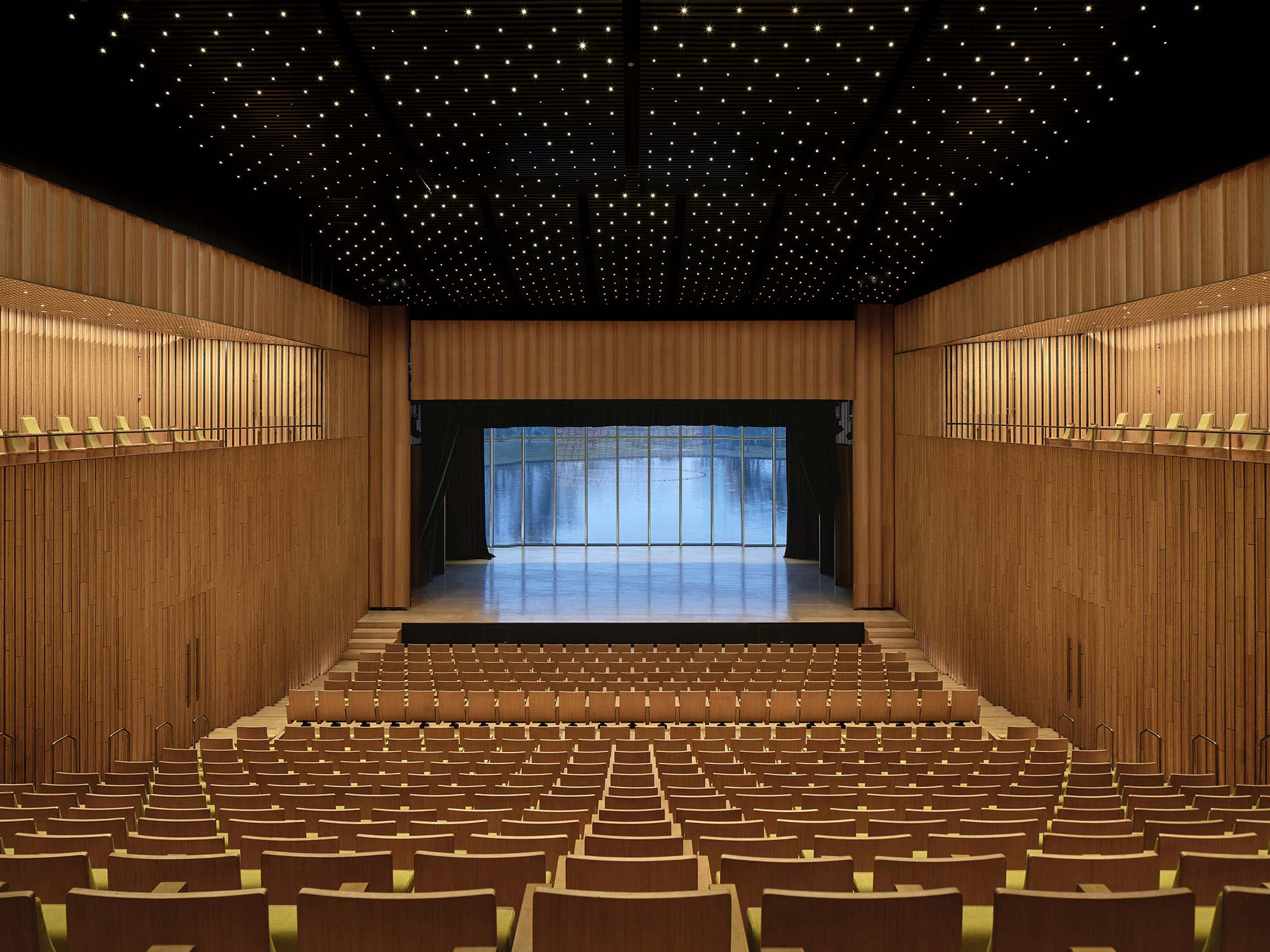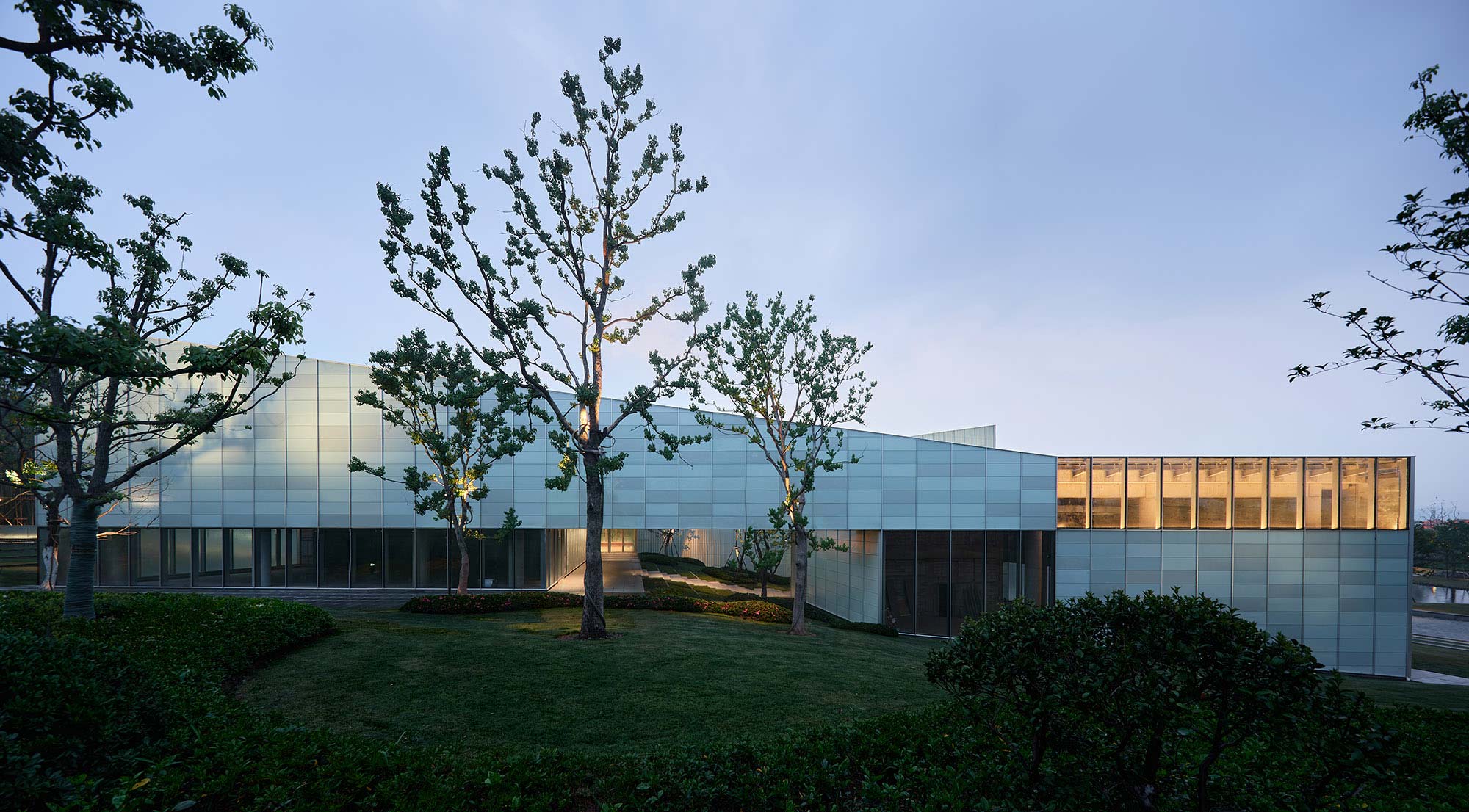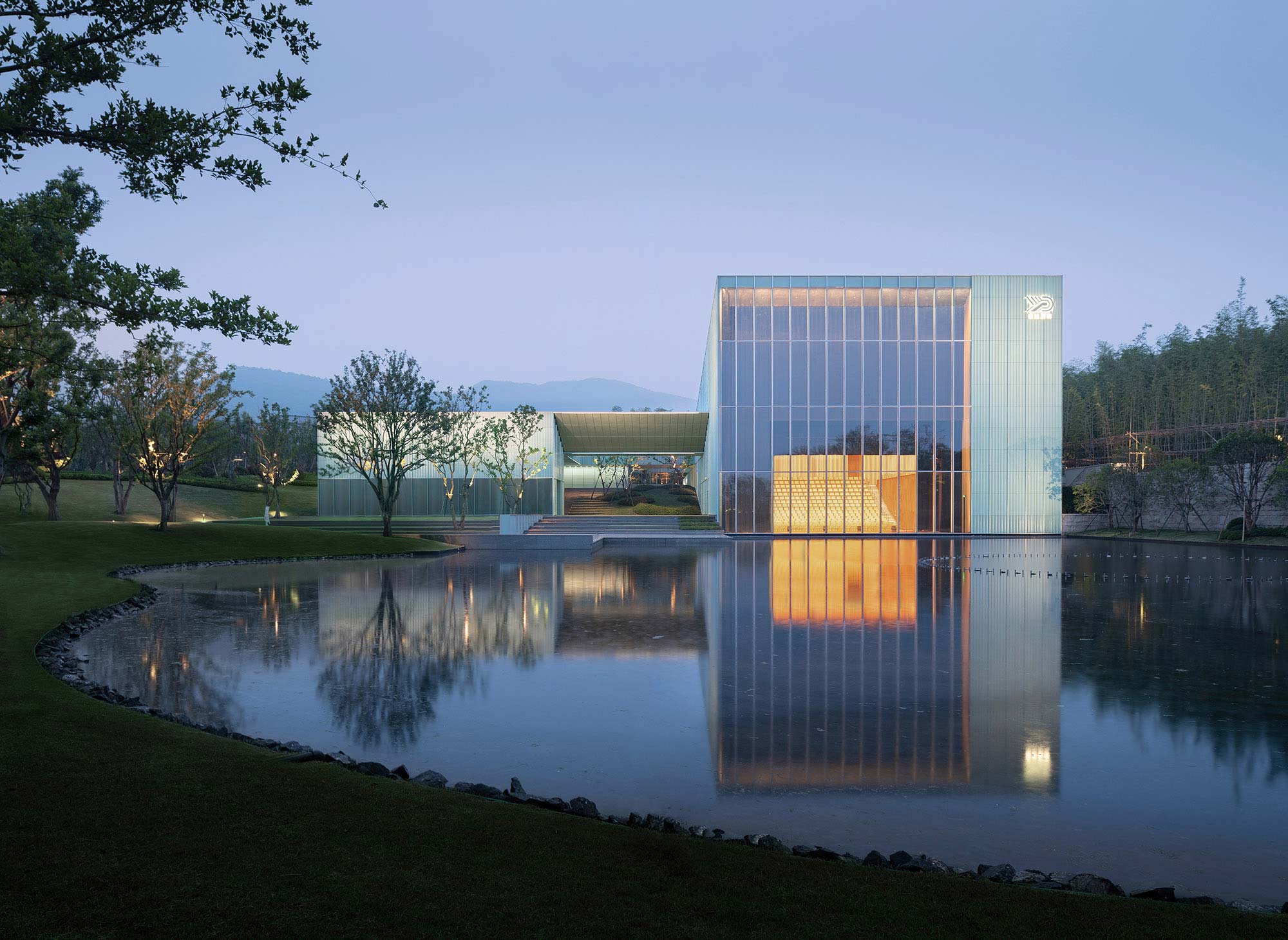宜兴是一个文化资源与自然资源都极为丰富的城市。雅达剧院坐落在江苏宜兴著名的大竹海景区内,基地位于400公顷原始山林覆盖的丘陵地带,毗邻阳羡湖畔,四周竹林环绕。山地、植被和湖泊构成了项目的景观系统。阳羡溪山诞生于小镇建设由狂热掘金向理性耕耘转向的时代节点,是开发商与建筑师当代城市化背景下的一次筹备周密的田园实验,也是首个有望实现“全域开放并自运转”的小镇开发项目。本设计旨在创造一个具备标志性的、开放的公共活动场所,同时延续当地自然生态。建筑师尝试探索一种新的观演空间类型,使“显著的外观”与“自然的体验”能够在这座建筑中平衡地展现。
牵引设计发展的是两个核心线索:“山想要什么?”与“人需要什么?”,这意味着建筑师并未将功能性需求——表演、观看、配套服务等作为组织空间的唯一原则,而是试图将身体经验与地貌特征融入其中,构建一种完整的空间秩序。剧院以中心庭院为核心展开,一系列灰空间穿插于其中。剧院的内、外边界被转译为数个气候开放的庭院。局部风雨廊将它们联系为一个自由的步行系统。动线设计顺应地貌,最大限度保持山体的原始坡度。有限的覆盖创造出轻盈、流动的底层空间,成为人感受自然的媒介。建筑在尺度中融入兼顾地形与身体的感知。自然与人工在微妙的平衡之间形成巨大的张力,看似孔武有力的建筑却实则轻盈地落在山谷之上。
空间的开放性唤醒人类细腻的感知,为来访者诠释艺术与自然交融的、独一无二的体验。底层步行系统构建起一系列场景,使人的身体不断穿梭于人工构筑与自然环境之间。其原型可以溯源至中国古典园林,内涵与东方自然观深刻呼应:在近人尺度,建筑不是牢不可破的实体,而是可以融入山水的“微自然”;在地景尺度,建筑是显现的文化标志,以人之名回应大自然的造物。我们期望的是一种逆绅士化的设计,让建筑产生的场域服务整个小镇的居民,音乐大厅以外的场所都是周边居民可以活动的场地。建筑就像一个多孔的海绵,将周围的环境与人汇聚于此。为正式的演出提供专业的场所只是建筑的表相功能,从关注建筑的自我到建筑向外输出。这样的布局下,社区生活产生的自由无序与舞台文化的庄重有序产生了对比:建筑是属于周围所有居住者的,人们在这里拥有了各种各样的自发性活动,这里才真正成为了小镇文化中心。剧院将不仅作为小镇演艺活动的举办地,更成为居民的文化生活主客厅所在。
前面提到我们一直在思考场地与环境的关系,希望得到一种内外渗透的体验保持室内室外的积极丰富的互动。因此我们设计了一个不同于传统鞋盒子式的观众厅。观众席顺应山势,逐级向上,正前方的演出舞台朝场地打开,自然毫无阻碍地倾泻涌入厅内,保持了内外关系渗透,让自然成为观众厅的一部分。 舞台背景创造性地采用落地玻璃幕墙,置身其中,仿佛置身于镶嵌在茶田水景之中的“宋式坐榻”。530座的多功能观演厅可实现开敞式与镜框式舞台的转换,不仅满足音乐会、戏剧演出的专业表演需求,亦适应其他文化活动场景。
在这样一个完整体量的建筑下,设计利用拼贴的方式建立了立面的秩序,进一步消解掉体量感,使一个庞然大物在远景、中景、近景都有可阅读的内容。建筑师研究本地建材,最终以宜兴本地产灰绿色陶板作为外墙材料,营造出简洁、典雅的氛围。竹文化与陶文化在宜兴当地也是十分盛行,于是我们采用当地烧制的陶板以竹节的方式呈现,作为立面单元肌理成为第一层秩序,再采取拼贴的方式形成第二层秩序,使得建筑在远景、中景、近景,人能感知到的细节是层层递进的。
The Yada Theatre is located in the Yangxian Xishan town of Yixing, a county-level city in the Jiangsu Province of China's southeastern region rich in cultural and natural resources. Since the Song dynasty, Yixing has been the capital of Chinese pottery production, known for its clayware. In addition, it contains China's largest bamboo forest, a significant tourist attraction. In the contemporary context of urbanization, Yangxian Xishan town is a successful rural revitalization practice of Yixing. It is the first small town development to achieve territorial openness and self-operation, and the Yada Theatre is the cultural landmark of the town. Adjacent to Yangxian Lake, the site is in a hilly terrain covered by 400 hectares of primitive bamboo forest. Mountains, bamboo groves, and lakes comprise the local landscape system. Within this unique geographical condition, the Yada Theatre incorporates the existing ecological aesthetics into its design. It develops a new approach to a cultural venue by integrating architectural morphology with nature in a manner that embraces modernity while conserving regional identity.
Besides taking the cultural functionality requirement as a principle for spatial organization, the design fuses physical experience and geomorphological features to create an integral spatial manner. From the central courtyard, a series of grey spaces expand in different directions and intersperse each corner. Their inner and outer interfaces are extended into courtyards and connected by covered corridors, providing a free circulation system that follows the slope of hills to maximally preserves the existing geomorphology. The decentralized architectural scale balances the perception of topography and body to establish an intimate bond between humans and the environment. This subtle synergy of the landform and constructional morphology generates a strong visual tension between the architecture and context that the entire structure appears to float lightly above the ground.
Implementing a traditional Jiangnan Garden layout is an anti-gentrification design strategy that discards the over-enclosing space and exclusive function of conventional theaters to provide community services for the surrounding residents, such as public gatherings, cultural events, and leisure activities. This layout echoes the Oriental perspective on nature which seeks to incorporate artificial structures into the landscape on a human scale while retaining architectural legibility. It presents the ground space in a communal, open, and accessible manner that encourages people to be involved in the space by roaming between the architecture and nature. Thus, the architecture is envisioned as a porous sponge that absorbs and embraces visitors and the surrounding environment. Performances will take place on the stage, while the remaining will become places to cultivate a variety of spontaneous activities and promote lively daily scenarios. This design approach extends beyond the architectural scope, aiming to benefit the local residents, coming visitors, and surrounding communities at large and the broader environment. In addition to serving as a venue for performing arts events in the town, the Yada Theatre becomes a gravitational field for cultural life that brings fresh vigor and new opportunities to the area.
The multifunctional auditorium adapts to the landform to maximize the preservation of nature on site and the diversity of spatial qualities. It extends to the stage along the hill's slope. It features a large glass window behind its stage that opens to nature and acts as a botanical backdrop to generate spatial permeability between the exterior landscape and the interior. As nature becomes a part of the performance, the auditorium delivers audiences a novel and delightful theatre experience within an attractive green context. The 530-seat auditorium can be used flexibly for any recreational activity by shifting between open and picture-frame stages to satisfy the varying setting needs of concerts, dramas, and large community events.
Under such an architectural scale, the design adopts a collage technique to eliminate the sense of volume, endowing architectural readability from a distance to a close-up. The facade incorporates material selection with the preservation of cultural heritage. It uses locally fired grayish green ceramic panels to present bamboo joints as facade units to form the first layer and then adopt a collage expression to form the second layer. The dual-layered façade system enables each architectural detail to be progressively perceived from a distance to close-up, transforming a modern architectural vocabulary into an emerging landmark while reorganizing local reminiscent.
业主 Client
雅达国际 Yada International
所在地址 Location
江苏省无锡市 Wuxi, Jiangsu
建筑规模 GFA
6,000 ㎡ 6,000 ㎡
项目类型 Type
文化 Culture
设计范围 Design scope
建筑、景观 Architecture, Landscape
设计周期 Design period
2019 - 2022



